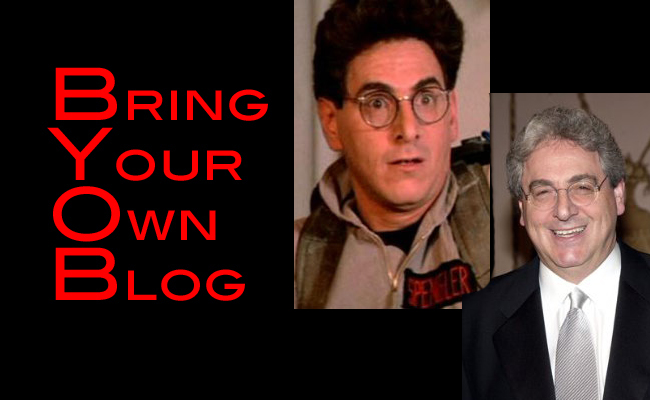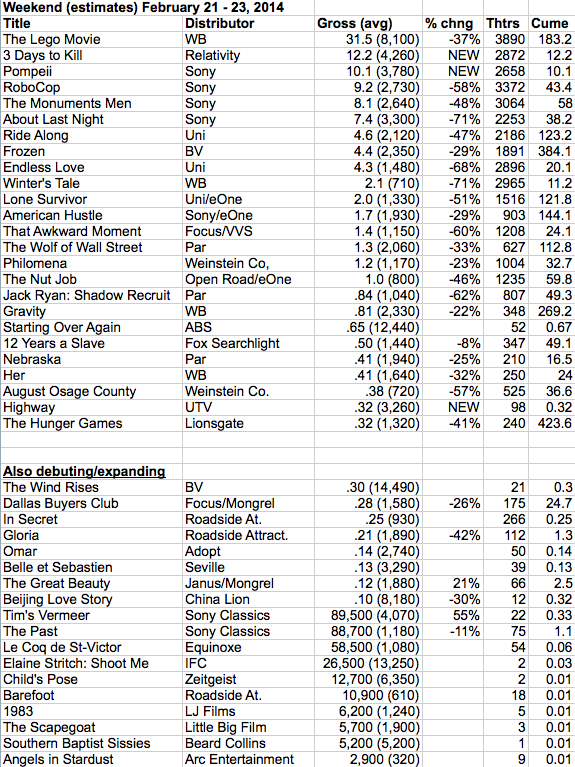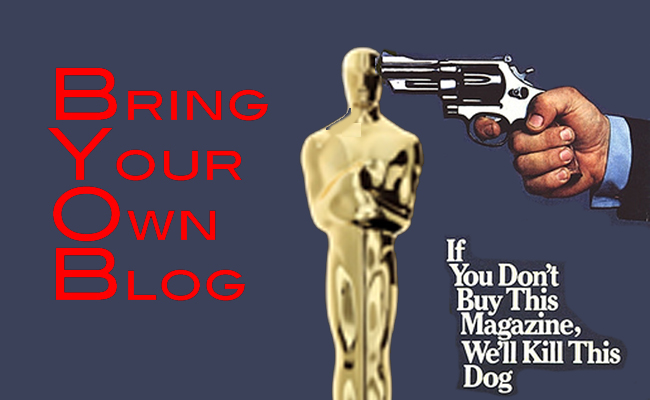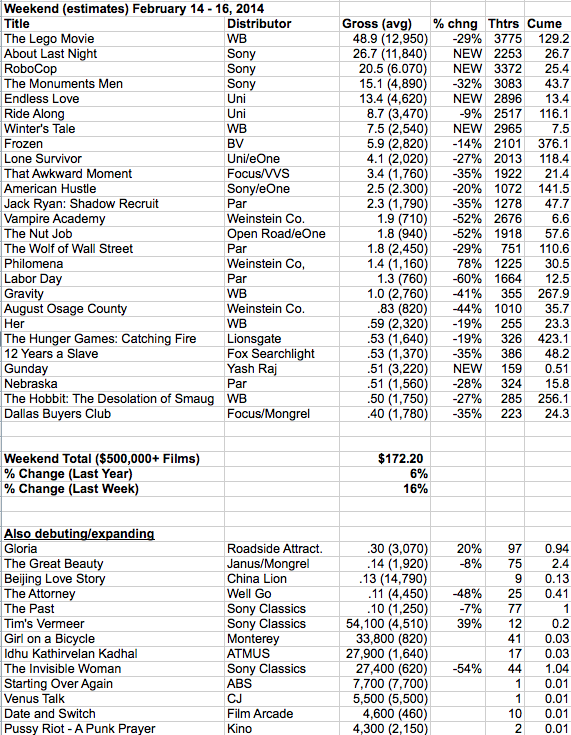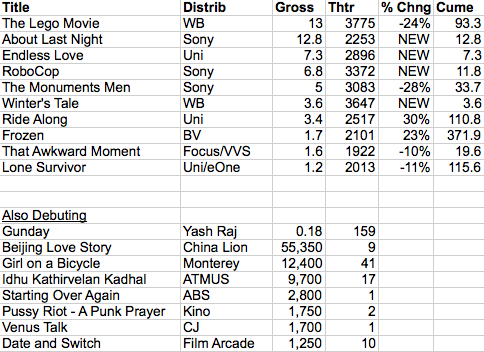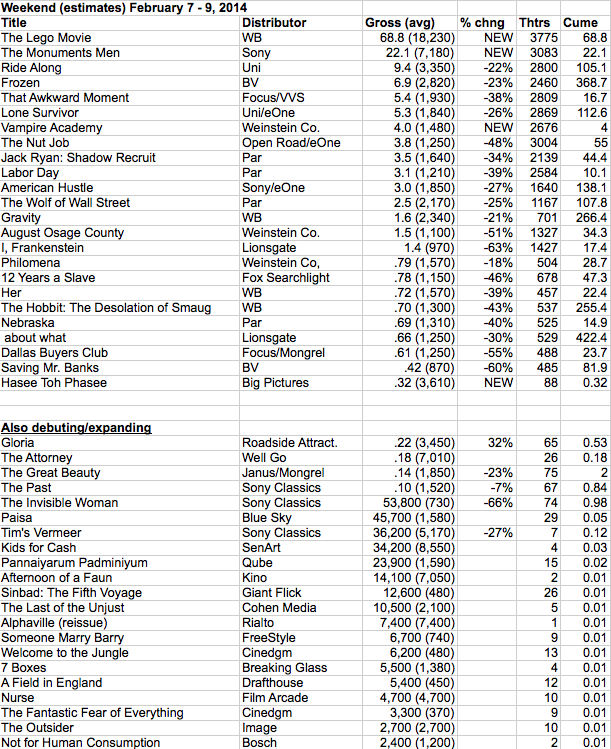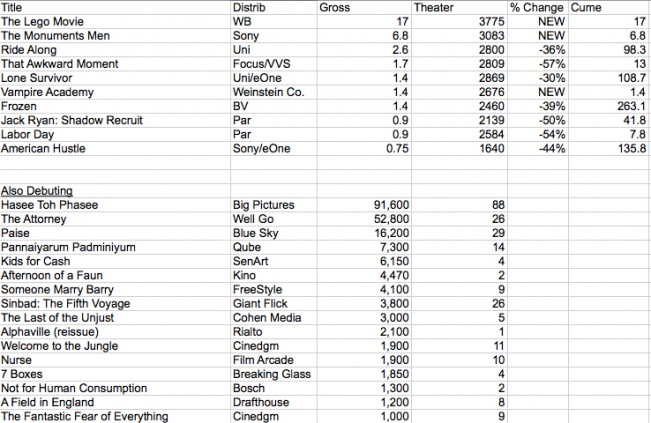The Hot Blog Archive for February, 2014
It’s Different

I started online in May 1997, 2 months short of 17 years ago.
People get a quizzical look in their eye when I mention what the web was like back then, but here is what the official Disney website looked like back when I started on the web. Here is what roughcut.com—already a year old—looked like when I joined the site. And roughcut.com as html started becoming something that you didn’t need a graduate degree to master.
I was writing a lot back then. And I was one of the few out there doing it. Here’s a October 1999 edition of The Hot Button and you can see, I’m all over the place. Back then, it was rare, now it’s the norm.
It was the Wild West, in many ways. I was working for a massive corporation but I had the firm support of my overlords and could go pretty much where I liked. I also was pretty good about separating my opinion from the facts in any given story… and I was writing about dozens of stories every week. My style, to be fair, did cause some readers to have difficulty making that separation, but in a decade-plus of writing The Hot Button, I was asked only once to make a retraction based on fact… and that was Anita Busch, re: Fight Club, and the facts were and still are accurate, though Anita still tries to argue otherwise.
The internet was still “the fucking internet” in those days. I remember one top publicist who refused to communicate via e-mail (though when I brought it up over a cocktail a few years ago, the by-then fully-wired guy completely denied it). Ain’t It Cool News was an inside/outside outfit, both playing and being played by industry insiders while pissing off studios by getting in the way of their publicity departments. Jeff Wells started his version of The Hot Button for Reel.com a couple of years after I launched online. (Here’s the earliest column I can find, from November 1999.)
Blogs were recently described as having a 20th anniversary, but I don’t recall the word being used much at all before 2000. And there were no real film blogs. Sasha Stone’s Oscarwatch.com and Tom O’Neill’s Gold Derby both preceded the blog, and both started as bulletin board sites. Many of those who went on to blog began as commenters on those sites, including Kris Tapley. And there were consultants reading the comments/postings on those blogs on a regular basis. A particular early aficionado of Oscarwatch was Tony Angellotti, long-timer with both Universal (live-action) and Disney (for animation). So awards consultants working the websites is hardly a new phenomenon.
In 1998, I remember feeling like I was a real contributor to the Oscar campaign of underdog masterpiece The Thin Red Line. I had left Entertainment Weekly in 1997 (I had been a contract writer for the magazine) but my relationships from the couple years I was there had translated to access for me and roughcut.com in those very early days of the internet participating in junkets and any studio-level stuff. And it wasn’t that I was any more insightful or worthy at the time. I would say that I was less so. But it was me and a bunch of newspapers and magazines and the trades. There was no Envelope… no Carpetbagger… no Deadline/Wrap. Moreover, I was free to write what I wanted. So while the trades were nothing but puffery and the major papers were self-positioned as being above the fray, I could fight whatever fight I wished.
Did I actually have any effect on the push to get The Thin Red Line nominated? Who knows? However many Academy voters were reading me in 1998, there was a lot less noise overall. With all three of the original major networks programming an 11:30/11:35 talk show, none of the three shows can ever be the old “Tonight Show,” not just because the format is less popular and not just because there is more outside competition, but because the multiplicity of three similar voices with some slight tonal variation lowers the water for all boats.
In 2001 and 2002, I was still explaining to most of the studios who the online Oscar players were.
Flash forward to 2013/2014…
Websites, Blogs and Twitter have eaten Traditional Media alive.
David Carr’s successful rise to beloved media celebrity, through a combination of a jaunty attitude as The Carpetbagger, a brilliant piece of reported autobiography, and playing the lead in a doc on the media department of the Paper of rRcord, has led the New York Times towards a level of Oscar obsession heretofore unseen (which Carr would have mocked in his Carpetbagger days… if it were some other paper doing the obsessing).
The LA Times has come out of bankruptcy… but is still living on the edge of the razor.
Both printed trades have owners who had no stake in Hollywood 10 years ago.
Longtime Hollywood Reporter princess Lynne Segall had spread her Oscar season advertising fairy dust on both the LA Times and Deadline and rthen eturned to The Hollywood Reporter, where trade journalism has given way to fashion coverage with a Hollywood twist. Now there are 3 outlets that rely on Special Issues and selling Oscar ads to stay in business.
Part of the success of The Hollywood Reporter, though many still claim that the pseudo-trade is high-profile but not profitable, is that they have brought glamor to the trade business. But the disconnect in this regard is that the interest in glamor has brought with it a distinct lowering of the bar for content. There are still critics… many of them the same ones you were reading 20 years ago. But facts have been replaced by factoids. And this is not just at The Hollywood Reporter. The bar has come down on content and up on style all over this area of journalism.
The mad genius of this is that outlets like THR and Variety and even the LA Times have figured out that even though their pot is smaller than it was in past seasons, it is still bigger for them than pretty much any internet-first outlet that competes on this front. So they can spend and offer cross-compensation for high-profile access that keeps them on top of the food chain. They can’t dominate on content anymore, so they have lost interest in great content (not that the trades were, in the good old bad old days, ever really after that) and are led around by hype.
But here is the subtle subtext of this movement that people—including those in the middle of it—tend not to think about. As the game of access becomes, even for trades, the coin of the realm, the power of the people controlling the access supersedes everything else.
The disruption of The Internet is no longer a disruption. The best whores/brokers have risen again… because in the end, who else will the powerful hand power to… and why would they do otherwise?
Further dissipating the authoritative voice is the teeming mass around these re-engaged top outlets. Out of sheer necessity, they create endless noise, obsessing on a handful of things each week, beating those issues to death, while not digging much deeper than the reactive mindset, and moving on to another set of “important issues” the next week.
Everything is an opinion. Everything is a whim. Everyone is an expert on every single thing.
Even argument has been reduced to how people manage their Facebook/Twitter/Instagram/Snapchat feeds. You can argue within 11 degrees of your opinion and occasionally, you will be attacked by someone 180 degrees on the other side, which instantly devalues that person’s opinion into being over-the-top and fringe.
There are very few real arguments, which lead to honest, earnest disagreement that may never be solved, but can be put aside for a time to appreciate your opponents wider array of positions… because disrespect has become the norm… because why respect anyone you disagree with since you can just surround yourself with a digital cabal of people who will tell you that you are right and the other side is solely for morons.
I truly miss arguing with assholes I know well. There are great big fights that need to be fought… but I now spent far too much time shocked by how lazy and disinterested the New York Times is about the beat I have lived in for the last two decades. It’s petty. So petty. But except for the people being directly damaged by the stupidity, which is often no one, given that the stupidity is often just publicity pretending to be investigative reporting, no one cares. Really. No one.
Nikki Finke has a lot of remarkable skill sets, many of which used to be what were considered the skills of a reporter. The ability to be an objective, honest journalist has never been amongst them (at least in the 15 years I’ve known her). But no one cares unless they are being yelled at her or having their truth shredded by her because some Nikki Whisperer told her to shred it even if she has no real understanding of the story or it hurts their cause in some way. As long as someone else is getting screwed by her gamesmanship, she is funny or even “a truthteller.” Of course, this is self-involved bullshit. When dealing with someone like Nikki, what is true when your advisor is being pummeled is just as true when you are the target.
And Nikki has become the template for a lot of journalists and a lot of outlets. Why? Because she got paid and she got relatively famous. And it doesn’t matter how and it doesn’t matter why.
That, my friends, has always existed. But it used to be a sideshow. Now it’s 90% of the carnival.
When I started in this business, if the reporting on a seemingly hot story didn’t turn out to be so heated, there were a few options. 1. Publish the reporting, even if it’s not so exciting. 2. Hold the story until there is a way of getting to the meat that the reporter and the editor can smell what’s rotting. 3. Spike it.
Nobody spikes anything anymore. (“Spike” meaning to just drop the story.)
One of the darkest days in the history of journalism was when the NY Times relaxed their unnamed source rules and came up with the “wouldn’t go on record because…” con. And it’s not because the New York Times has abused it so (though they certainly have at times). It’s because everyone else seems to have decided that the journalistic standard is now one source and a sense they are telling the truth, even if they are inherently biased and have skin in the game that makes it possible, if not probable, that by sourcing them without a name you are doing their bidding.
I have spent much of the last 17 years of doing what I do: decoding news stories. My favorite pieces are ones that I do not have to decode. My least favorite stories are the ones in which I can tell you—with 90% certainty—who sourced what angle in the piece and what their real goal is in doing so. Can you tell by the tone of this piece which way the trend is going?
I guess what I am really wanting to say is… this used to be more fun.
And I don’t want to part of a collective that, even if they let me do my work as I see fit, is likely to force to me to make lame excuses for poor journalistic decisions made in the name of keeping the operation going.
I don’t want to be part of the noise, indistinguishable, even to myself, from the din.
I want to let movies breathe. I want to breathe. I want to believe in the ambitions of most everyone who does something along the lines of what I do. I want to be challenged smartly, beaten as appropriate, and made better by my failures. I want to love things without cynicism.
I love so much of what I have had the privilege to do for a very nice living for a very long time. But I do feel these days like I am being moved around the chess board in a way that stifles growth.
For the first time in my journalistic career, I have to remind myself to play the game.
I hate that.
Because playing the game reflects as poorly on my as it does on anyone I point my finger and an accuse of playing the game.
I got to spend some time with Mike Fleming. I like Mike Fleming. But I don’t know him well enough to know who he was 10 years ago. All I do know is that he does the thing he does really well. And now, there are 10 other people trying to do what he does. I wonder if he cares. I wonder if he is okay with the changes in his game that he has been forced into by circumstance (mostly profitable circumstance).
I love doing DP/30 because it is, like me and my style or not, a simple attempt at finding something real. People who do the work of making movies and television are passionate about their work. They truly give a damn. And they would, most often, rather focus on their work than on the business manifestations around it. I cherish that. I am hungry for more.
So, of course, that work is not a significant revenue stream. If it was, my life would be an embarrassment of riches. And who needs that.
I miss a lot of the work I have left behind. Some of it has been imitated. Some of it has been made irrelevant. Why do I need to do my own daily chart—which no one was doing until years after I started doing it—when there are so many others doing the same thing now? Would I really be serving anything other than my ego and my hit count? But much of it was fun. It was simulating. It was challenging.
I write most of the things I want to say, professionally, on Twitter now because 140 or 420 characters should be enough. I appreciate the economy. And I tend to lecture (see: above).
I’m not going anywhere, if you thought that was where this was leading. But I do feel like I am back at the bottom of the hill, looking up. And the challenges are quite different. “What I want out of this” is a much, much more complicated thing than it used to be.
I mean… it’s not. I want to do the work I want to do and make a reasonable amount of money doing it in order to keep doing the work and paying for a life.
But Eskimos want saunas and monkeys want opposable thumbs and all that. I’ve had my sauna and my thumb for a long time… and eaten them too.
I don’t want anyone off of my lawn. I like people on my lawn. I like living in big, loud cities.
I guess I just want to see everyone working to the top of their intelligence. That is something I learned in improv. It’s something that I want from myself. Because it’s fun.
I spend 6 months of my year dealing with a statue of a bald guy named Oscar handed out by 6,000 people who can’t agree on anything except for their own importance (and not even that, really) and shouldn’t it be fun? It used to be fun.
22 Comments »Harold Ramis & The Last 35 Years Of Comedy

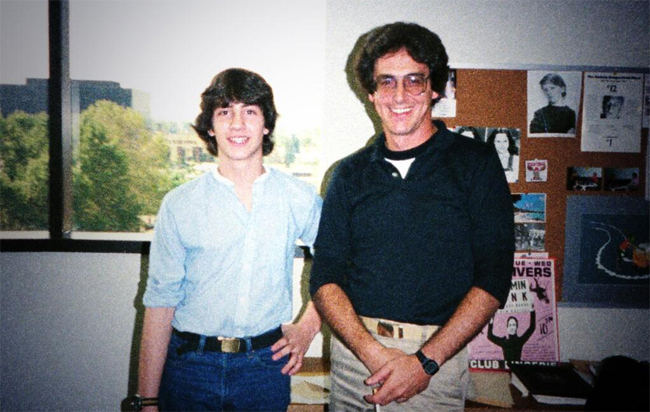
Stolen from Judd Apatow’s Twitter feed.
On October 11, 1975, comedy changed.
Before that, the pieces were there. Second City (both Chicago and Toronto) and The National Lampoon were hot. The Groundlings (based in LA) were new and promising. But the launch of Saturday Night Light brought all the pieces together. One chunk of the original SNL Not Ready For Primetime Players came from the Lampoon live show… some of whom had been Second City performers. Some talent, like Christopher Guest and Tony Hendra, didn’t make the leap at that time. Other SNLers came from Second City Toronto. Lorraine Newman came from The Groundlings. Jane Curtin and Garrett Morris came from outside of the improv comedy world, performing in other theatrical venues.
Harold Ramis was a part of that National Lampoon/Second City Toronto scene. Like Bill Murray, he got relegated to writing before he became a television – then film – performer. Murray went to SNL and Ramis went to Second City Toronto, where SCTV launched.
After showrunning SCTV, Ramis’ side-job as screenwriter took over with National Lampoon’s Animal House in 1978. The connection to National Lampoon was stronger than the one to SNL – John Belushi and really nothing else – as Ramis worked with Doug Kenney and Chris Miller on the script. Kenney (along with Brian Doyle-Murray) would also write Caddyshack with Ramis. But it was Stripes, which Ramis wrote with his Meatballs co-writers Daniel Goldberg and Len Blum, where the world really got a full taste of Ramis as a performer. Ramis was also written into Ghostbusters, which he co-wrote with Dan Aykroyd, and made him recognizable worldwide.
In the midst of all that, the only film of these classics that Ramis directed was Caddyshack. (John Landis did Animal House, then Ivan Reitman directed 3 of the next 4.)
Film comedy was also messing around with the sex comedy at the time (Porky’s, et al) and Amy Heckerling came of age with Fast Times, but there wasn’t a lot that stuck in the early 80s (aside from randomly-spilt seminal fluid watching soft-core cable through squiggly lines or the nightly showing of Hardbodies) except for John Landis, who followed Animal House with The Blues Brothers, Trading Places, and Coming To America. Eddie Murphy (with a mixed lot of directors) and John Hughes led the way through the rest of the 80s.
There were some good comedies in the early 90s, but around the time Reitman had gotten caught up in Schwarzenegger as a comedian, Ramis came up with a masterpiece, as writer and director, Groundhog Day. It was a film in which his generation finally grew up.
A year later, the next big comedy director,s The Farrelly Bros, took control of the comedy world with Dumb & Dumber, which led into a 7-year run of dominance. Taking over from them was Apatow, Sandler, Ferrell and others who still dominate the comedy scene, really. The scene aches for the next vision, as Sandler sequelizes Grown Ups, Ferrell sequelizes Anchorman, and Apatow, who stays young by drinking the blood of Lena Dunham, is making personal movies about middle age (That Was Really 45). But no one has wrestled the crown away and they keep making big hits, whether critics like it or not.
So if I were going to make a list of the most important comedy directors of the last 35 years (and I haven’t even mentioned Rob Reiner, Nora Ephron, Jay Roach, Frank Oz, Jonathan Lynn, Zucker/Abrahams, Martha Coolidge, Tom Shadyac, Adam McKay by name, or Todd Phillips, amongst others), I would say it’s groups that have created major landmarks over this time period, not (generally) individuals.
Reitman/Ramis/Landis
The Farrelly Brothers
Reiner/Ephron
Murphy & Co.
Apatow/Ferrell-McKay/Sandler & Co.
There are still good and great comedies made every year. But I personally feel like we are in a fallow period. It felt like we were going to go into the Sacha Baron Cohen era for a moment… but it only lasted a film and a half, really. Wes Anderson is great, but so unique that he doesn’t really lead. Same with Spike Jonze. Are the next seriously important comedy voices going to be primarily on TV? Maybe.
So is, as someone suggested, Harold Ramis one of the most 5 most important comedy directors of the last 35 years? No.
Just because Ramis was part of Stripes and Ghostbusters doesn’t really mean we get to forget that Ivan Reitman’s important. Or because Ramis co-wrote Animal House, forgetting Landis and Doug Kinney is kind of a nasty way to love Harold. The late great Mr. Ramis cannot be given credit for the form of improv known as The Harold (created by Del Close, who Ramis ust have worked with at some point) nor for Harold’s Chicken Shack of Chicago.
But he was a game-changer. And he was one of the 25 or 30 people, who are writers, actors, and/or directors, not only created classic comedies, but set the tone for comedy for many years of these last 35. He seemed to be at or around every key comedy trend from the early 70s into the early 90s. And that is a truly remarkable legacy.
19 Comments »BYO Obit: Ramis
A brilliant, lovely, kind man.
17 Comments »Weekend Estimates by 3 Days To Klady
Historically, the only 1st Quarter movies to get to $150m faster than The Lego Movie were The Hunger Games, The Passion of the Christ, Oz The Great & Powerful, and Alice in Wonderland. $200m should come next Friday or Saturday, pushing it ahead of Alice on the speed clock to that landmark. Lego is actually well ahead of Frozen‘s 3rd wide weekend cume, will be ahead again after its 4th weekend, but will probably fall back to even with Frozen because Frozen‘s 5th weekend was Christmas/New Years week, in which it actually grew 45%. So Lego will not likely reach the $350m+/potentially $400m+ range of Frozen or come close to The Hunger Games‘ $408m or even the The Passion‘s $371m domestic, but has a real shot at catching/passing Alice in Wonderland‘s $335m domestic to become the 3rd biggest Q1 movie in history. That’s not nothing. In fact, it’s as huge as the hype. Perhaps more huge. Sue Kroll and WB Marketing proves once again that when they have a movie that catches the zeitgeist, they can hit it way, way out of the park.
Speaking of zeitgeist, Frozen passed Despicable Me 2 this weekend to not only become the #1 animated film of 2013 and the #3 domestic release of 2013, but has gotten there with enough steam to make a run at the Top 2 domestic box office grossers of 2013 (Iron Man 3 and The Hunger Games: Catching Fire).
Don’t be surprised if The Oscars opens with Ellen DeGeneres doing a Frozen bit… maybe with a bow and arrow from Hunger Games to boot.
I don’t think I mentioned when it happened that American Hustle is now David O. Russell’s highest-grossing domestic movie (and will likely be his biggest worldwide as well). The Wolf of Wall Street is Scorsese’s biggest worldwide hit and will not likely be his top domestic grosser (still $20m behind The Departed). Gravity is Alfonso Cuarón’s biggest domestic hit, beating out his Harry Potter movie by $20 million so far (and will never catch Potter‘s $65m ww advantage). 12 Years A Slave is now a $119 million worldwide grosser, easily Steve McQueen’s biggest in all territories. Captain Phillips has done more than double what any Paul Greengrass movie not called Bourne has done worldwide and triple domestically. So if you add some perspective to the Oscar group, the numbers look even better.
Have I mentioned 3 Days To Kill or Pompeii yet? No. Well, why would I?
On the arthouse circuit, the two winners were The Wind Rises and Elaine Stritch: Shoot Me with estimated/reported per-screens between $12k and $14k.
17 Comments »Friday Estimates by Master Box Office Klady
Weekend Estimates by Everything Is Still Legos Klady
The Lego Movie had the best 2nd domestic weekend of the last year, aside from Iron Man 3 and The Hunger Games: Catching Fire (aka the #1 an #2 films of 2012), outdoing both Despicable Me 2 and Monsters University and their summer berths. Now… we need to show some restraint on that stat, as both of last summer’s animated smashes were well ahead of Lego at the end of the 2nd weekend, as both opened bigger and had the summer advantage on the weekdays. But still, quite impressive for a February animated release. Lego will likely be the #2 February release of all time (current #2, Hitch, with $179.5m) by this time next week… maybe a couple days after… with only The Passion of The Christ‘s $370 million looking at it in its rearview mirror.
Play the theme song!
Though About Last Night came up short of $30m for the 3-day, it is still part of a remarkable run by Kevin Hart. He’s worked his way into that space where Eddie Murphy once was, Jim Carrey once was, and where Will Ferrell still lives sometimes… a comedy star who makes movies that do not cost a lot to make, so there is a ton of profit. The next step is making cheap movies where the star comedian is by far the most expensive commodity in play. That still tends to make a ton of profit. The phase after that (aka, the career destroyer) is when the star comedian wants to make more expensive films or dramas that don’t fit the expected role of comedian.
It will be interesting to see what the next couple of deals for Hart are in this economic climate. I don’t know that I believe it, but with Jennifer Lawrence allegedly getting under $20 million for each of these last three Hunger Games movies, that suggests that the door is not as wide open as it once was. Honestly, I don’t know how J-Law isn’t getting $30m or $40m a movie for all three of the last three films in the series. At that price, she would literally still be a bargain. The old-school expectation of $20 million deals for Kevin Hart’s next couple movies probably won’t be quite that big, even if the production costs are under $20, making the price tag on the films $40 million or less. Current movie economics weigh international as a heavy part of the equation and “black movies” still don’t do much business overseas. (Eddie Murphy kinda leaped over that issue. Beverly Hills Cop did $85m international back in 1985… and before that, Eddie was always teamed with a white star.) If Hart is considered a sure bet to do $80m domestic, that’s $44m in rentals, maybe another $5m in international rentals as his star rises, post-theatrical markets, and a minimum $15m in marketing against the revenues. So $40m is a pretty good bet… with the potential of a lot of upside. If Hart can ever crack the international market, $50m productions become cash cows.
RoboCop is estimated at $20.5m, which may be a touch high, but it will also benefit from the holiday a bit. Hard to say how one should see this number. Decent. Not thrilling. The international has it nearing $100m already, so there’s that. Legs, both foreign and domestic, will tell the story in the end.
Endless Love and Winter’s Tale tried to ride the Valentine’s Day thing to modest results, the one that no one really could comprehend from the marketing getting the more modest results. Endless is exactly the kind of movie that would have been helped exponentially by having stars that the potential audience had some kind of relationship with. Beautiful images in ads, female director with some chops, familiar title… but no real heat. And I know that Colin Farrell is in Winter’s Tale. Aside from that, a complete blank. The book on these movies is not terribly unfamiliar. You need a clear pitch and some actors that audiences want to see fall in love. Easier said than accomplished, I guess.
The Oscar chart for the weekend looks like this…

February ain’t doing any Oscar movie too many favors. Philomena passes $30 million. 12 Years A Slave can’t quite get to $50 million domestic.
31 Comments »Friday Estimates by About Kevin Hart Klady
Great Moments in Sam Jackson (Not So Great For Sam Rubin)
Rubin apology after the jump…
Weekend Estimates by Klady
The joke about the disappointment of an estimated $22.1 million opening for The Monuments Men is that is really the best of Clooney’s career for a Clooney movie, except for The Perfect Storm, which made studios consider him a box-office actor. Aside from that, it’s Batman & Robin, three Oceans gang movies, and Gravity, which is a Sandra Bullock movie that WB used Clooney’s name in relentlessly to keep it from seeming like a one-person film… and when people figured it out, they went in droves anyway.
So in Realityland, this is actually a very successful launch for this film, not a “it came in second” disappointment.
As for The Lego Movie, everything is awesome, and the ad campaign featuring the song and the visuals was a clear humdinger. Next week, the word-of-mouth benefits start kicking in.
It’s been a very strong early 2013 so far. Even The Nut Job is a hit, now Open Road’s #1 grosser. Really, except for Jack Ryan & Frankenstein, it’s been all good stories lately. And now, with Lego, it looks like we will have our first serious blockbuster of 2014.
23 Comments »Review-ish: The Grand Budapest Hotel

I actually feel a little stupid trying to review this movie.
You see, Wes Anderson is a painter. His canvas is film. His paints are all the tools one can use to create a piece of art, including actors.
To reduce a painter to each stroke is only interesting from a distant perspective. How does Wes Anderson make films… what visual language is he working with… how does he use actors… etc, etc, etc? But I doubt there were as many as six speaking roles in this film with any of these great actors working more than 3 or 4 days. This does not devalue the performances. No one else could do them any better or, in some cases, with any success at all, except for those chosen by Wes. And they are not there as cogs in a bigger machine. There are absolutely unique and necessary and, mostly, gone in a flash.
For instance, Tilda Swinton does something she’s never really done here. And it is a thing of epic beauty. And she might have 3 minutes of screen time in the whole film.
I will say this… The Grand Budapest Hotel is more of a Rube Goldberg machine than any of his other pictures, though that feeling has been in most of them. It is absolutely relentless as a story. Constant forward motion. All pieces moving.
It was interesting to see The Great Museum, a Fredrick Wiseman-esque doc about the restoration and reopening of Austria’s state museum. There is a glorious piece of art, described as “an 18th century executive toy” which is a gold boat with what looks like ceramic sails, which has a mechanism in it to move characters of the deck and, in the good old days, fire off a cannon on the 1.5 foot long ship’s deck. This movie reminded me of that boat.
Really, Wes Anderson is the Willy Wonka of art films. He works in a land of pure imagination. You never know what will be around the next corner. But you do have a sense of what the chocolate will taste like.
Anyway… the movie is pleasure after pleasure. Many audiences will be unhappy by how briefly some of their favorites appear in the film. It’s almost unfair to tell people that Bill Murray is in the film… because he is there for an instant. Surely less than a minute in total screen time. But he makes for a wonderful couple of beats.
GB is a Ralph Fiennes movie. And he is perfection. By his side is Tony Revolori, who hits the right Wes tone on every note. Willem Dafoe is a ton of fun as the film’s Boris Badenov. Saoirse Ronan gets a bit of screen time, but doesn’t get to do too much besides look angelic. F. Murray Abraham is your living narrator and is well measured from start to finish.
But make no mistake… this is a Ralph Fiennes movie. And though it is February, it is the kind of turn that generates a lot of awards talk. A lot of great decisions by Ralph, a lot of great decisions by Wes, and a lot of great decisions by Ralph & Wes turn this into a character that can be completely obvious and completely unexpected all within a sentence or two.
What is the movie about? It’s a complicatedly simple adventure. It’s a ride… even though it is still an art film. Just take the ride… describing the stops isn’t going to make it any better, just ruin great surprises.
If you like Wes Anderson movies, you should like this movie, so long as you are not going to feel cheated by the many brief performances (which I would not call cameos, because they don’t feel like that… they feel organic, not stunty… but very limited). And if you can’t get over that, get over yourself. Ralph Fiennes hits it out of the park. Take that and stop being greedy for more.
13 Comments »




